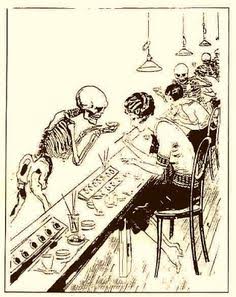I’m pretty inexperienced with non-fiction. I would rather enter a new world through books, instead of inserting myself into one that already exists. However, The Radium Girls grabbed my attention with its mildly horrifying accounts. Kate Moore’s narrative non-fiction debut is the story of the young women who painted glow in the dark watch dials with radium laced paint in the 1910s and 1920s. This era was the height of radium-based products that were believed to be cure for everything. There were advertisements for “radium-lined jars to which water could be added to make it radioactive.” It was deemed the “miracle drug.”

Of course, we now know just how dangerous radium is.
Radium Girls centers around the young women who worked for a company called the United States Radium Corporation, or USRC. More specifically it centers around 10 or so of the women who painted watch and clock dials with radium paint. They were well paid and the positions were considered very glamorous. In their workspace, there was a darkroom where the women could check their work but they used it mostly to paint glow in the dark mustaches on their faces. In order to be more precise about their painting, they employed what was called the lip pointing technique, in which the girls would use their mouths to finely point the paintbrush bristles, dip in the paint, then lip point again. This would turn out to be small but deadly process.
 Most, if not all, of the girls who worked for USRC started getting ill. Some had sore mouths, some had achy joints, some started walking with limps, and some showed all of the symptoms. Several of the women developed deadly sarcomas. Since radium affected each girl differently, the sources of their illness were misdiagnosed. Syphilis, “phossy jaw,” early onset arthritis, etc. were some of the main diagnoses. These “radium girls” were dying left and right, and USRC kept denying that their deaths were work-related. Finally, with the help of sympathetic doctors and committee agents, radium was finally pinpointed as the cause of these deaths and illnesses.
Most, if not all, of the girls who worked for USRC started getting ill. Some had sore mouths, some had achy joints, some started walking with limps, and some showed all of the symptoms. Several of the women developed deadly sarcomas. Since radium affected each girl differently, the sources of their illness were misdiagnosed. Syphilis, “phossy jaw,” early onset arthritis, etc. were some of the main diagnoses. These “radium girls” were dying left and right, and USRC kept denying that their deaths were work-related. Finally, with the help of sympathetic doctors and committee agents, radium was finally pinpointed as the cause of these deaths and illnesses.
Cue the legal battles. These women wanted justice for how horribly they were treated; newspapers were calling them the “living dead.” USRC still denied they were involved, going as far as to blatantly lie and cover up medical exams given they themselves. I won’t tell you what the final judgment was, but it was a long and hard journey to get it.
As someone who hasn’t read a lot of nonfiction, I really enjoyed The Radium Girls. There’s an epilogue that delves into how radium and other radioactive elements started being handled, as well as the laws put into place to protect those who handle these elements regularly.


Comments are closed.